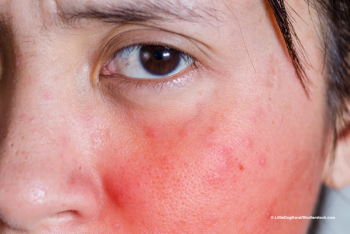
In the final part of her three-part series on cosmetic dangers, Tracy Schroeder-Swartz, OD, MS, FAAO, explains the importance of keeping patients informed of cosmetic dangers and how to properly report cosmetic problems.

In the final part of her three-part series on cosmetic dangers, Tracy Schroeder-Swartz, OD, MS, FAAO, explains the importance of keeping patients informed of cosmetic dangers and how to properly report cosmetic problems.

Michael Cooper, OD, takes a look at how the Japanese treat allergic conjunctivitis to gain a different perspective on treatments. What he finds is that we aren't so different after all.

We asked industry experts for their top suggestions to colleagues on how to best manage allergy.

Inflammation may lead to heightened peripheral sensitization and stimulation through a developing concept in which neuroimmune cross-talk causes the confounding interplay of both signs and symptoms in dry eye and allergic disease.

As an allergy sufferer myself, I tend to pore over the journals and literature to learn what new exciting technologies may be on the horizon. When I came across epicutaneous immunotherapy (EPIT), my mind went in a multitude of different directions about the endless possibilities for both systemic and ocular allergy management.

In a poll fielded to Optometry Times and Ophthalmology Times readers, we asked both ODs and MDs what they used for first-line therapy for allergy patients.


Depending on where you live, spring is here-or at least on its way. It’s the time of year to thaw out along with the trees, grass, and flowers. With spring comes our promise to get ourselves into shape for the summer, and life gets busier with more outdoor activities for the whole family.

The major type 1 immunologic hypersensitivity reaction involving the conjunctiva is commonly referred to as allergic conjunctivitis.

It is a precarious position considering the desire to find the perfect remedy- yet with vernal keratoconjunctivitis (VKC), there is no magic bullet.

On the surface, eyecare providers may not fully appreciate the prevalence and complexity of ocular allergy and its clinical management; we learn that it is a relatively simple disease defined by ocular itch.

As technology leaps forward with medicine, it is prudent at times to appreciate how far we have come in managing and treating allergic eye disease. In fact, let us look back to the beginning in ancient Rome with the first recorded case of atopy. One of these authors, Suetonius, wrote with great detail in his biographical text De vita Caeserum about the distinctive lives of the first Roman emperors.

As optometry’s scope of practice has increased, optometrists have embraced allergic eye disease. Ocular allergies have multiple effects to patients in our practice. But, if allergies are unidentified because symptoms may not be present during office visits, patients may treat themselves.

Ideally, an ocular allergy medication should provide clinically significant improvements of the annoying or even incapacitating ocular itch with minimal dosing. While this is a desirable goal, it leads to challenges of the amount of dosing to achieve this objective and patient compliance with such dosing.

If you think more allergy patients are landing in your chair every year, you’re absolutely correct. The prevalence of allergy is rising worldwide to near epidemic proportions and carries a significant burden for both the individual patient as well as healthcare systems globally.

Right about now, you are probably wondering, “Is there a real connection between the plant and the late inventor?”

What would be the response if I told you that prescribing an allergy medication outright was a bandage or knee-jerk approach? Now, before everyone comes after me with pitchforks, hear me out.

With Earth’s climate change, both higher temperature and carbon dioxide levels have been inducing vigorous amounts of allergen production from multiple plant and tree species blooming faster than expected for at least the past 160 years.

How often do you ask a child in the exam chair if her eyes were ever itchy or watery? When I started to ask this question to every patient in my pediatric population, it was quite evident that there was an undiscovered gold mine in my anterior segment practice. Allergies in the pediatric population are trending upward in a startling and truly dangerous manner.

The advent of spring yields the annual pilgrimage of patients into our offices complaining of the itchy, watery eyes of allergy. As any eyecare practitioner can attest, ocular allergy is one of the most common presentations to an eyecare practice.

Allergic diseases have greatly increased in industrialized countries. About 30 percent of people suffer from allergic symptoms, and from 40 to 80 percent of these have ocular symptoms.1 We all prescribe topical medicines for our patients with ocular allergies; their use has become almost second nature. These medications do a truly remarkable job of helping our patients who suffer from seasonal or perennial ocular allergies. I like to temper these pharmacologic recommendations with some common sense ideas that will complement the pharmacological treatment and greatly alleviate the patient’s symptomatology.

According to a study recently published in the British Journal of Ophthalmology from Kochi Medical School in Japan, “tacrolimus eye drops are highly effective in treating allergic conjunctivitis with proliferative lesions and/or corneal involvement, and may reduce or replace topical steroid use.”

Like a lot of folks, I suffer from seasonal allergies. While the red, watery eyes do spring up (no pun intended), this time of year I am much more bothered by the constant, unrelenting runny nose accompanying my seasonal allergy attacks. Which shouldn’t be surprising. -42% of patients suffering from allergic conjunctivitis also experience symptoms of allergic rhinitis (AR).

Andrew M. Brown, MD, is an allergist and immunologist with 47 years of experience and practices in otolaryngology, allergy, and immunology, and has been in practice in Gadsden, AL for the last 40 years. He graciously took time from his extremely busy practice, the largest allergy practice in the area, to talk with me. I started with the question: What would you like to tell an in-the-trenches optometrist about allergy?

Ocular allergy is one of the most common ocular surface diseases seen in a primary eyecare practice. Allergic conjunctivitis (AC) often exists concurrently with rhinitis and asthma, and patients with allergic rhinitis frequently present with symptoms of AC. AC is often linked to allergic rhinitis and requires co-treatment.